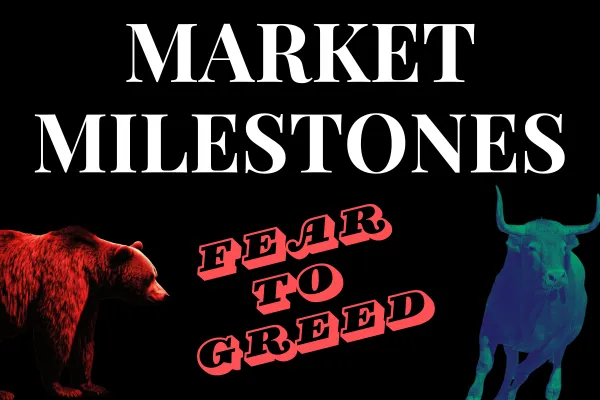Market Milestones: Fear to Greed
Sentiment in the markets flips on a dime. Just one month ago, we were at a 3—deep in “extreme fear” on the Fear & Greed Index. Today, we’re at 62, firmly in “greed.”
Real Life Trading Blog

Sentiment in the markets flips on a dime. Just one month ago, we were at a 3—deep in “extreme fear” on the Fear & Greed Index. Today, we’re at 62, firmly in “greed.”

We also saw a Death Cross on the QQQ on April 14th. I joked that day that the market is now destined to go to zero—but in reality, it’s an interesting indicator, even if it is overhyped and over-discussed. It’s not a tool to time market tops or bottoms, but it can help gauge big-picture direction. Today, we’re going to compare the 2022 Death Cross with today’s setup and look for key similarities and differences.

The markets finished the week strong after bouncing off the 100-week SMA. There are three days left in the month, but as it stands, SPY and QQQ are printing massive monthly hammer candles. I went back through history to find similar massive hammer candles and study how they behaved.

Between tariffs and earnings, you’d think it couldn’t get any crazier—yet here we are. TLT still can’t catch a bid no matter what’s happening. It’s been in a downtrend since the double rate cut whammy back in September. Even during a technical bear market, TLT couldn’t find buyers. In fact, the bond market forced a pivot from the Trump administration on April 9th. This is a major problem for the U.S., which needs lower interest rates to refinance nearly a third of its absurdly massive debt load this year. If you're still holding onto the old-school 60/40 portfolio, you've likely been punished in both of the last two bear markets—2022 and now. Bonds didn’t hedge anything. That’s exactly why I’ve shifted to what I call the millennial 60/40 split: 60% Bitcoin, 40% equities. It's a modern, conviction-based portfolio allocation for those who have been truly orange pilled.

This is an ideal time to be selling puts on companies you’d love to own at prices you’d be happy to pay. Over the last 36 trading days, I’ve posted six put sales that brought in $722.00 in premium—enough to pay for over a full year of the RLT Newsletter. On Thursday, I posted four more put sales, for another $458 in premium set to expire next week. If you’re not already part of our thriving RLT Newsletter community, now’s the ideal time to join.

All major markets broke down in a big way on Thursday. SPY dropped 4.93%, QQQ fell 5.35%, IWM slid 6.42%, and SMH led the plunge, closing down 8.65%. The Magnificent 7 took a beating as well—AAPL, AMZN, and META all dropped roughly 9%. There was blood in the streets as the market scrambled to price in the impact of Liberation Day and Trump’s reciprocal tariffs. While it’ll take time to truly understand the effect of these tariffs, the market's initial reaction made one thing clear: if they’re implemented as laid out in the Rose Garden, the outlook isn’t bullish. The odds of a recession are skyrocketing—and if nothing changes with the tariffs, 2025 is going to get a lot bumpier.
Real Life Trading Blog

Sentiment in the markets flips on a dime. Just one month ago, we were at a 3—deep in “extreme fear” on the Fear & Greed Index. Today, we’re at 62, firmly in “greed.”

We also saw a Death Cross on the QQQ on April 14th. I joked that day that the market is now destined to go to zero—but in reality, it’s an interesting indicator, even if it is overhyped and over-discussed. It’s not a tool to time market tops or bottoms, but it can help gauge big-picture direction. Today, we’re going to compare the 2022 Death Cross with today’s setup and look for key similarities and differences.

The markets finished the week strong after bouncing off the 100-week SMA. There are three days left in the month, but as it stands, SPY and QQQ are printing massive monthly hammer candles. I went back through history to find similar massive hammer candles and study how they behaved.

Between tariffs and earnings, you’d think it couldn’t get any crazier—yet here we are. TLT still can’t catch a bid no matter what’s happening. It’s been in a downtrend since the double rate cut whammy back in September. Even during a technical bear market, TLT couldn’t find buyers. In fact, the bond market forced a pivot from the Trump administration on April 9th. This is a major problem for the U.S., which needs lower interest rates to refinance nearly a third of its absurdly massive debt load this year. If you're still holding onto the old-school 60/40 portfolio, you've likely been punished in both of the last two bear markets—2022 and now. Bonds didn’t hedge anything. That’s exactly why I’ve shifted to what I call the millennial 60/40 split: 60% Bitcoin, 40% equities. It's a modern, conviction-based portfolio allocation for those who have been truly orange pilled.

This is an ideal time to be selling puts on companies you’d love to own at prices you’d be happy to pay. Over the last 36 trading days, I’ve posted six put sales that brought in $722.00 in premium—enough to pay for over a full year of the RLT Newsletter. On Thursday, I posted four more put sales, for another $458 in premium set to expire next week. If you’re not already part of our thriving RLT Newsletter community, now’s the ideal time to join.

All major markets broke down in a big way on Thursday. SPY dropped 4.93%, QQQ fell 5.35%, IWM slid 6.42%, and SMH led the plunge, closing down 8.65%. The Magnificent 7 took a beating as well—AAPL, AMZN, and META all dropped roughly 9%. There was blood in the streets as the market scrambled to price in the impact of Liberation Day and Trump’s reciprocal tariffs. While it’ll take time to truly understand the effect of these tariffs, the market's initial reaction made one thing clear: if they’re implemented as laid out in the Rose Garden, the outlook isn’t bullish. The odds of a recession are skyrocketing—and if nothing changes with the tariffs, 2025 is going to get a lot bumpier.

* All investments carry a certain level of risk, including the potential loss of principal invested. No investment strategy can guarantee a profit or protect against loss in periods of declining values. Please consider your objectives and risk tolerance before investing. Past performance is not indicative of future results.
© Copyright 2025 Real Life Trading, All Rights Reserved